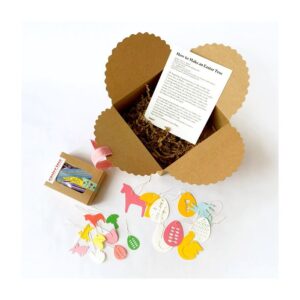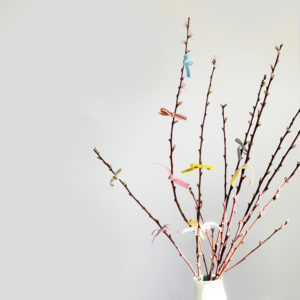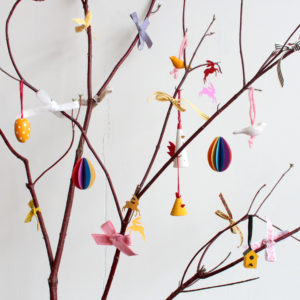
The beginning of spring means it is time to make your Easter Tree or Påskris – a popular tradition in Sweden.
Download our how-to guide here!
In the markets of Sweden you will see buckets and baskets filled with colorful feathers and ribbons for Påskris. The ribbons are tied to twigs and placed in a container. Much like a Christmas tree, you then can add decorations but this time they are all types of spring symbols such as roosters, hens, birds of all kinds, butterflies, and of course, eggs as colorful as the feathers.
You can find materials you need for your own Påskris at Ingebretsen’s.

Despite the colorful twigs and decorations, the origin story is not as cheerful. In the 1600s Swedes took sticks and beat each other with them on Good Friday to commemorate the suffering of Jesus. In the 1800s and 1900s, they decided to stop hitting each other and started to decorate the twigs and they became a symbolic decoration for Easter.
It’s been suggested that the feather twigs represent the palm leaves that were placed on the ground for Jesus’ donkey to walk on in his triumphant return to Jerusalem celebrated on Palm Sunday. Since there are as many palm trees in Sweden as there are in Minnesota (outdoor palm trees to be precise), this was the best they could do to imitate this tradition.
Some Swedes say the Easter Tree symbolizes the sweeping away of winter. The twigs represent a broom and the feathers get caught in the broom as we sweep.

But since Easter Feathers really don’t look much like palm leaves there may be a couple other reasons for their use (that we are making up right now):
- It is a warning to all birds that if they chose to “drop” on the local wagons, carts, or Volvos they may find themselves in the same situation as their colorful companions
- Much like Linus’ Great Pumpkin, these feathered twigs are offered to the Great Easter Spring Chicken to show her that we are worthy of the warmer weather and that under our parkas we bear clothing of radiant colors
- It is an attempt to appease Höðr – the Nordic God of winter, who is not so keen on being pushed aside. Nor is Höðr pleased with the delight and happiness his leaving seems to bring to the natives
Whatever the “truth” is, we love these Easter Trees and if you haven’t made one in the past we hope you will start a new tradition.
Here is a YouTube video to help you create your Påskris.
